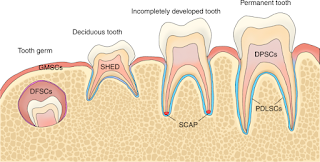Flow Cytometry Applications to Dentistry
Flow Cytometry Applications to Dentistry
Stream cytometry is a high-throughput cell investigation strategy that uses monochromatic light and explicitly calculated locators to gather the phone's size, granularity, and intricacy in view of the level of light dissipating embraced.
Cells can likewise be ready for fluorescence estimations during stream cytometry by consolidating fluorophores, fluorescent atoms with explicit adsorption, and emanation frequencies, permitting numerous non-covering markers to be utilized. Stream cytometry might be used in dentistry to analyze cells gathered from the oral depression: gums, tongue, uvula, hard and delicate sense of taste, and so on, including bacterial cells.
The early utilization of stream cytometry in dentistry
Mangkornkarn et al. (1991) inspected dental mash tissue in a spearheading review, where stream cytometry permits preferable impression of cell elements over recently utilized old style strategies, where static tissue segments are ready. The cells were stained with monoclonal antibodies to lymphocyte subpopulations, exhibiting the practicality of stream cytometry in deciding pulpal tissue cell heterogeneity.
Early strides into the utilization of fluorescence stream cytometry in oral microscopic organisms recognizable proof were attempted by Barnett et al. (1984), where notwithstanding showing unmistakable light dissipating qualities, Streptococcus mutans and Actinomyces viscosus exhibited a lacking contrast in cell morphology to empower solid recognizable proof by stream cytometry at that point, with the creators using species-explicit immunofluorescent antibodies to accomplish detachment all things considered.
Understand Here: Using Flow Cytometry in Disease Diagnosis
Current stream cytometry can evaluate a few boundaries at the same time and is consistently utilized in both examination and clinical dentistry. In research, stream cytometry is valuable in surveying the effect of new antibacterial medications or materials, for example, dentin holding specialists (Lapinska et al., 2019), looking at the state and cell piece of oral tissues in illness states, and a wide assortment of other explicit examinations for which high-throughput multiparametric investigation of cells would be helpful. Stream cytometry can be utilized in the center as a demonstrative technique for different sicknesses, where white platelet count or other characteristic biomarkers can be counted and looked at.
A few exploration bunches have exhibited cryopreservation of human dental mash undeveloped cells and resulting stream cytometry, making long haul filing of tests conceivable (Malekfar et al., 2016). This can be helpful in the drawn out investigation of sickness states and for intra-and between persistent examination studies, especially in saving important undifferentiated cells. Undifferentiated cells are consistently distinguished and ordered in a high throughput way utilizing stream cytometry and can be gathered from the dental mash in the focal point of the tooth for use in examination and medication (Bakkar et al., 2017).
What can stream cytometry instruct us concerning our eating routine?
Stream cytometry also has applications in food science-related dentistry. For example, Chang et al. (2012) utilized stream cytometry to take a gander at human gingival fibroblasts under receptiveness to butyrate, a short chain unsaturated fat metabolic consequence of stomach microorganism handling of dietary fiber. Oddly, butyrate quelled gingival fibroblast improvement by cell cycle catch without starting apoptosis, making a noxious outcome by conveying responsive oxygen species. This could achieve attracting out bothering periodontal sicknesses, destroying the for the most part examined clinical benefits of butyrate (Liu et al., 2018).
Another report by Onyango et al. (2020) researches the "fundamentally remarkable" oral microorganisms neighborhood metabolic profile upon receptiveness to various sugars: sucrose, trehalose, kojibiose, and xylitol, finding that the last two assist less tooth with spoiling related species. Kojibiose, explicitly, was shown to eagerly stay aware of the standard bacterial neighborhood inferable from its low availability to bacterial absorption.
Kojibiose is a disaccharide with a sweet taste, suggesting that less sugar calories are supposed to give an identical enjoyableness. It is accessible in honey anyway is for the most part testing to consolidate on a cutting edge scale, but another biochemical strategy utilizing proteins to convey the sugar from a speedily manufactured starting material could allow it to be even more reliably coordinated into food rather than extra calorific different choices (Diez-Municio et al., 2013).
References:
Mangkornkarn, C., et al. (1991) Flow cytometric examination of human dental pound tissue. Journal of Endodontics, 17(2). https://www.sciencedirect.com/science/article/abs/pii/S0099239906816079
Barnett, J. M, et al. (1984) Automated Immunofluorescent Speciation of Oral Bacteria Using Flow Cytometry. Journal of Dental Research, 63(8). https://journals.sagepub.com/doi/abs/10.1177/00220345840630080501
Liu, H., et al. (2018) Butyrate: A Double-Edged Sword for Health? Drives in food, 9(1). https://academic.oup.com/drives/article/9/1/21/4849000
Malekfar, A., et al. (2016) Isolation and Characterization of Human Dental Pulp Stem Cells from Cryopreserved Pulp Tissues Obtained from Teeth with Irreversible Pulpitis. Journal of Endodontics, 42(1). https://www.sciencedirect.com/science/article/pii/S0099239915008997?casa_token=ifRPATJW720AAAAA:JnBrT5lqd6yHi-TX5LtBSWz8Gys6RxJdwbRN8Gv5QKkXbW2PArd47VsDTML8Z3do6lzYu6784Q
Lapinska, B., et al. (2019) Flow Cytometry Analysis of Antibacterial Effects of Universal Dentin Bonding Agents on Streptococcus mutans. Particles, 24(3). https://pubmed.ncbi.nlm.nih.gov/30717140/
Onyango, S. O., et al. (2020) Oral Microbiota Display Profound Differential Metabolic Kinetics and Community Shifts upon Incubation with Sucrose, Trehalose, Kojibiose, and Xylitol. Applied environmental microbial science, 86(16). https://www.ncbi.nlm.nih.gov/pmc/articles/PMC7414948/
Diez-Municio, M., et al. (2014) A sensible biotechnological process for the useful mix of kojibiose. Green science, 4. https://pubs.rsc.org/en/content/articlelanding/2014/GC/C3GC42246A
Bakkar, M., et al. (2017) A Simplified and Systematic Method to Isolate, Culture, and Characterize Multiple Types of Human Dental Stem Cells from a Single Tooth. Grown-up juvenile microorganisms. https://link.springer.com/show/10.1007/978-1-4939-6756-8_15




Comments
Post a Comment